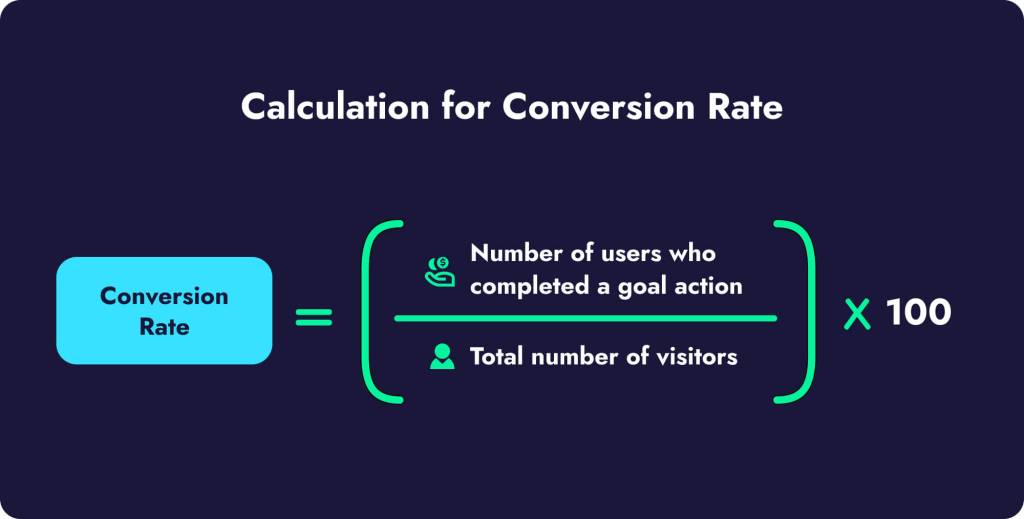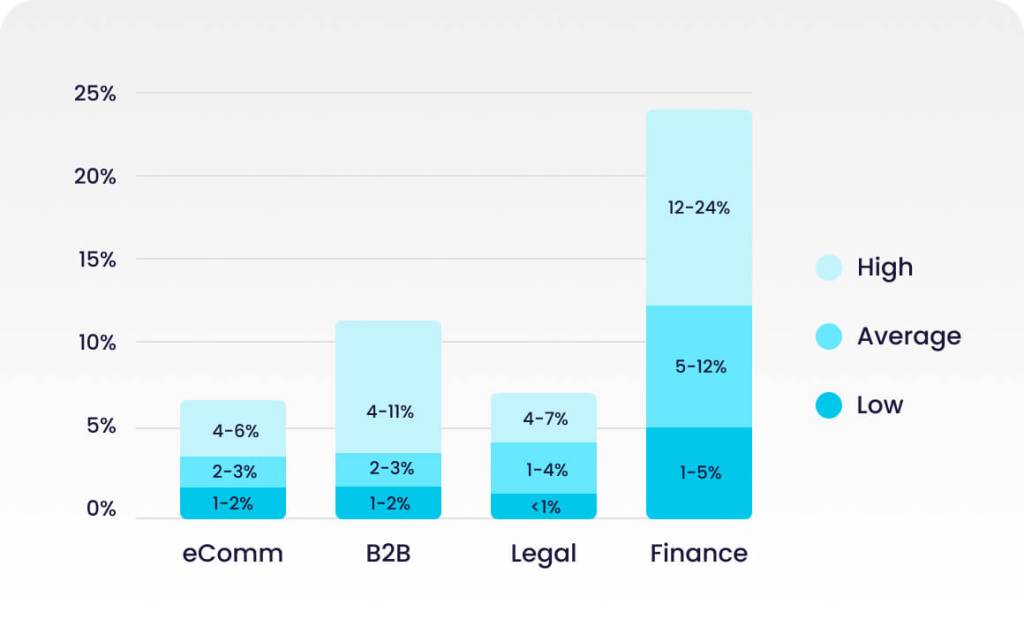What is CRO?
In today’s competitive online landscape, Conversion Rate Optimization (CRO) has emerged as a vital strategy for businesses. But what exactly is CRO?
At its core, Conversion Rate Optimization refers to the systematic process of improving a website or landing page’s performance to increase the percentage of visitors who take desired actions you’re aiming for—whether it’s making a purchase, subscribing to a newsletter, or completing a form.
The key objective of CRO is to optimize the existing traffic and maximize its conversion potential, guiding them through the conversion funnel with ease and efficiency. The CRO process involves carefully analyzing various elements on a website, such as layout, design, navigation, content, and calls-to-action, to identify areas for improvement. By testing different variations and tracking user responses, CRO helps businesses make informed decisions about which changes yield the best results.
How are conversion rates calculated?
A conversion rate is the percentage of website visitors who complete a desired action, such as making a purchase or signing up for a newsletter. It is a key metric used to measure the effectiveness of a website or marketing campaign in achieving its goals.
The conversion rate is calculated by dividing the number of conversions (desired actions) by the total number of visitors, and then multiplying by 100 to express it as a percentage. The specific desired actions or goals can vary depending on the website’s purpose and objectives, such as making a purchase, signing up for a newsletter, filling out a form, or completing a download.

For example, if a website receives 1,000 visitors in a month and 100 of them make a purchase, the monthly purchase conversion rate would be 10% (100 divided by 1,000, multiplied by 100).
Simple enough, right? There are also plenty of conversion rate calculators out there if you want to skip the math.
What is considered a good conversion rate?
Determining a universally “good” conversion rate is challenging, as it varies across industries and depends on several factors.
For example, in e-commerce, an average conversion rate of 2-3% is considered typical, while high-performing websites can achieve rates of 5% or more. Conversely, lead generation websites often strive for conversion rates around 10% or higher. It’s important to remember that a good conversion rate is relative and specific to each industry and website. The key focus of Conversion Rate Optimization is to continuously improve and exceed your own conversion rates, aligning with industry benchmarks as a reference point. By analyzing data, conducting tests, and implementing optimization strategies, businesses can work towards achieving and exceeding their unique conversion rate goals.

How does your business’s conversion rate measure up against the industry average? Request a free CRO audit and receive a tailored improvement roadmap today!
Why do you need CRO?
Implementing Conversion Rate Optimization strategies not only leads to higher conversion rates but also enhances customer satisfaction and loyalty. When visitors find a website easy to navigate, relevant to their needs, and conducive to completing their desired actions, they are more likely to engage further and develop a positive perception of the brand.
The Benefits of Conversion Rate Optimization (CRO) Include:
- Increased conversions: CRO boosts the number of visitors taking desired actions on your website.
- Enhanced user experience: CRO creates a seamless and enjoyable experience for visitors, removing obstacles, as well as improving usability and user satisfaction.
- Higher ROI: CRO maximizes the impact of your marketing efforts, resulting in a higher ROI.
- Cost-effective solution: CRO leverages your existing traffic to generate more sales or leads, reducing the need of acquiring new visitors.
- Improved customer insights: CRO provides valuable data and insights into customer preferences and behaviors.
- Increased customer trust and loyalty: CRO builds trust, fosters loyalty, and encourages repeat conversions.
- Competitive advantage: CRO gives you an edge over competitors in the digital marketplace.
- Cost-effective solution: CRO optimizes existing traffic, reducing the need for acquiring new visitors.
- Long-term benefits: CRO ensures sustainable growth by continuously adapting to user preferences and market trends.
How to get started with CRO
If you’re just starting out with CRO, it’s important to follow a systematic approach to ensure effectiveness and success.
Step 1 – Define your conversion goals
Begin by clearly defining the specific actions or outcomes you want visitors to accomplish on your website. Whether it’s making a purchase, subscribing to a newsletter, filling out a form, or any other desired action, having well-defined conversion goals will provide a clear direction for your optimization efforts.
Here are some common conversion goals examples:
- E-commerce: Online purchases, add-to-cart actions, email sign-ups, product reviews, cross-selling.
- Software/Tech: Free trial sign-ups, software/app downloads, demo/consultation requests, contact form submissions, upgrades/subscriptions.
- Education: Course enrollments, educational resource downloads, program/admissions inquiries, webinar/workshop registrations, testimonial submissions.
- B2B: Request for quote, demo requests, consultation bookings, lead generation form submissions, content downloads.
Step 2 – Analyze your website’s performance
Dive into the data and analyze various metrics to gain insights into your website’s current performance. Examine metrics such as bounce rates, click-through rates, conversion funnels, and user behavior patterns to identify areas that might be causing friction or hindering conversions. By understanding how users interact with your site, you can pinpoint specific pain points that need improvement. There are a lot of free or affordable user insight tools you can use for this purpose.
Step 3 – Run a CRO audit
A CRO audit is a comprehensive evaluation of a website to identify areas for improvement and optimize conversion rates. A CRO professional can uncover important insights in a CRO audit that regular people might miss when looking at user insight data, including identifying conversion barriers, providing data-driven insights, enhancing user experience, optimizing conversion funnels, maximizing ROI, and driving continuous improvement. A CRO audit can unlock the secrets to skyrocketing your conversions. Get a FREE CRO Audit Today!
Step 4 – Generate hypotheses
Once you have gathered data and identified potential issues, it’s time to generate hypotheses for optimization. Based on the insights gained from your analysis, formulate educated guesses about the changes or optimizations that can positively impact conversion rates. These hypotheses should be backed by data, research, and best practices rather than relying solely on personal opinions.
Step 5 – Formulate CRO testing roadmap
Now that you have defined goals and formulated data-driven hypotheses, the next step is to prioritize tests by considering their impact on conversion rates and the effort required for implementation. Remember to take into account any dependencies or conflicts between tests and conduct a cost-benefit analysis to evaluate the potential returns of each test. With this information, create a roadmap that outlines the sequence of tests to be conducted. Continuously monitor and analyze test results, making adjustments to your roadmap as needed. Iterate and refine your testing approach based on insights gained from the tests.
Step 6 – Create and implement A/B tests
A/B testing techniques can be utilized by presenting different versions simultaneously to your website visitors and measuring their performance against your conversion goals. By developing variations of your web pages or specific elements within them, you can test them against the current version. This methodology of testing enables you to determine which variations yield better results and offers valuable insights into user preferences and behaviors.
Step 7 – Monitor and analyze test results
Stay closely engaged with the results of your A/B tests, immersing yourself in the impact that each variation has on your conversion rates. Dive into the numbers, exploring key metrics like click-through rates, conversion rates, and engagement levels. By measuring and comparing the performance of diverse variations, you’ll gain insight into which elements truly drive conversions. These insights will guide your decision-making, empowering you to make informed choices with your website and future optimizations.
Step 8 – Iterate and refine
Conversion Rate Optimization is an iterative process. Based on the insights gained from your test results, refine your website and implement the changes that have proven to be successful in improving conversions. Continuously iterate on your optimization strategies, incorporating new hypotheses, conducting additional tests, and ultimately, turn your website into a high-converting machine.
Above is a brief summary of how to get started with CRO. Here’s a comprehensive guide on everything you need to know about the CRO process.
CRO testing methods
CRO testing involves various methodologies to improve website performance and increase conversion rates. Here are explanations of some common types of CRO testing:
- A/B Testing: A/B testing compares two versions of a web page (A and B) to determine which version performs better in achieving the desired conversion goal. The traffic is split between the two versions, and their performance metrics, such as click-through rates or conversion rates, are measured. A/B testing helps identify the most effective variation to implement.
- Multivariate Testing: Multivariate testing is similar to A/B testing but involves testing multiple variations of different elements simultaneously. Rather than testing complete page versions, multivariate testing allows you to assess the impact of various combinations of individual elements. This method helps identify the optimal combination of elements for maximizing conversions.

– A/B/n testing is technically a variation of A/B testing. While traditional A/B testing compares only two versions (A and B), A/B/n testing expands the scope by including more than two variations (A, B, C, D etc.) for comparison. Each variant represents a different design, layout, or content element. The traffic is split between the variants.
– Multivariate testing, on the other hand, involves testing different combinations of individual elements on a web page to determine their impact on conversions. Instead of testing complete page versions like in A/B testing, multivariate testing focuses on assessing the performance of specific elements when combined in different ways. For example, you might test variations of headlines, images, and call-to-action buttons to understand how different combinations affect conversions. Multivariate testing provides insights into the optimal combination of elements for maximizing conversions.
- Split URL Testing: Split URL testing is conducted by directing different segments of traffic to different URLs or web pages. This method is useful when testing significant changes to the overall page structure or design. It allows for more comprehensive comparisons between variations.
- Redirect Testing: Redirect testing is similar to split URL testing but involves redirecting users to different variations within the same URL or web page. It enables testing and comparing different designs, layouts, or content elements on a single page without altering the URL or affecting search engine optimization.
What tools are needed for CRO
To effectively carry out CRO and maximize website performance, utilizing various tools and software can greatly assist in data analysis, experimentation, and optimization. Here are some essential types of tools commonly used in CRO:
- Web Analytics Tools: Tools such as Google Analytics, Adobe Analytics, or Kissmetrics provide valuable insights into user behavior, conversion funnels, and key performance indicators (KPIs), aiding in informed decision-making for CRO strategies.
- Heatmap and Click Tracking Tools: Tools like Crazy Egg, Hotjar, or Mouseflow offer visual representations of user interactions through heatmaps, click maps, and scroll maps. These tools help identify areas of user interest and engagement, facilitating optimization opportunities.
- A/B Testing Tools: A/B testing software such as Optimizely, VWO, or Google Optimize allow for conducting experiments by testing different variations of web pages or specific elements. This enables data-driven decision-making by comparing performance metrics and determining winning variations.
- User Feedback and Survey Tools: Tools like Qualtrics, SurveyMonkey, or UserVoice enable the collection of user feedback through surveys, polls, or feedback forms. This user input helps uncover valuable insights, pain points, and areas for improvement within the conversion process.
- Session Recording Tools: Tools such as FullStory or SessionCam provide session recordings that allow you to observe and analyze user interactions and behaviors on your website. These recordings help identify usability issues and areas where optimization can enhance the user experience.
- Landing Page Builders: Landing page builders like Unbounce or Instapage offer user-friendly interfaces for creating and testing landing pages. These tools facilitate rapid prototyping and optimization of dedicated pages for specific campaigns or goals.
- CRM and Marketing Automation Tools: Customer Relationship Management (CRM) platforms like Salesforce or HubSpot, combined with marketing automation tools, provide insights into customer interactions, lead nurturing, and personalization opportunities. Leveraging these tools can enhance the entire customer journey and optimize conversions.
By leveraging these tools and software, you can gather data, analyze user behavior, conduct experiments, and make informed decisions to optimize their conversion rates. It’s important to select tools that align with your specific goals, budget, and requirements for successful Conversion Rate Optimization endeavors.

